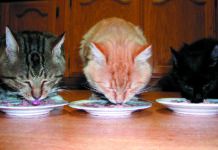Our cat has to go on a weight management diet, or a prescribed diet to cut down on the risk for kidney stones, or a special diet for heart or kidney disease. You might think that all you have to do is stop feeding the food he has been eating and start feeding the new one. That does work in some cases, but much of the time, a more gradual transition is necessary to avoid the unpleasant symptoms of gastrointestinal upset — gurgling, excess gas, diarrhea, vomiting, or constipation. How gradual?
Some cats will need a month to 6 weeks to make the transition comfortably, although in most cases, a week should do, says Tufts board-certified veterinary nutritionist Deborah Linder, DVM. She recommends the transitioning ratios in the box below as a general guideline.
The guideline is for percentages by calories, Dr. Linder comments, not the amount you scoop into a measuring cup. That’s because a cup of the new food may contain more or fewer calories than a cup of the old. She says to check the label for calories per cup or can.
Even if you follow this guideline to the letter, your cat may have some soft stools and a bit of stomach gurgling. That’s okay if your pet is still acting his usual peppy self, the doctor says. You’ll just want to stretch the transition a little longer. Go back to the previous ratio of old-to-new food for a day or two and then continue from there.
But call the veterinarian if your cat’s stomach upset is continuing to cause problems — including bouts of liquid diarrhea that last more than a day, or symptoms like vomiting that are making him not want to eat or engage in his usual activities. It’s possible the new food is simply the wrong choice. Or maybe it is the right choice, but the switch has to be made even more slowly. The doctor will advise you on whether to stick with the current choice or try a new diet.
Whatever happens, don’t panic. There are usually several different types and brands of foods for medical issues that need to be addressed with diet. If one food turns out not to be the solution, another will.
Leaving the Decision Up to the Cat (Kind Of)
If your cat is easily stressed or is really bothered by new foods and is apt to avoid them, rather than starting by gradually changing the ratio of the new food to the old, it may be better to offer both the old and new foods side by side and let your pet make the choice. If your cat doesn’t want to try the new food, don’t worry. Just remove it after an hour and try again at the next feeding. Always provide fresh food at each feeding; the offering has to be enticing. After several tries, the new diet should become familiar enough that your cat is willing to try it. It’s at that point that you can slowly decrease the amount of the old food while increasing the new.






Demokrasi, hakkettiğimizden daha iyi yönetilmeyeceğimizi garanti eden bir sistemdir.- George Bernard Shaw